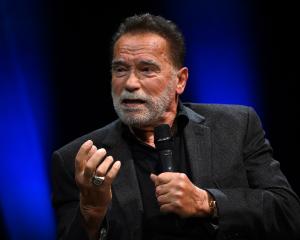Deborah Netburn, of the Los Angeles Times, celebrates a fitness craze that has survived well into middle age.
Today's gymgoers are moving in different ways with different rhythms, but they're all trying to get the heart rate up in an interesting, engaging way.
In short, they're doing aerobics.
More than 40 years after Dr Kenneth Cooper released the book, Aerobics, the form of exercise hasn't died.
It has morphed with the times, giving itself new names and shedding the leg warmers and the headbands.
Dr Cooper, then a young United States Air Force physician, invented the word "aerobics" for his 1968 book of the same name - tacking an "s" on to the medical adjective "aerobic" as a way to describe the kind of exercise he was touting.
In the book, he defined aerobic exercises as those that "demand oxygen without producing an intolerable oxygen debt, so that they can be sustained for a long period of time".
He didn't particularly like the word, and he didn't want it to be the title of his book.
"The publisher thought we should call the book Aerobics. I disagreed," he said recently from his office at the Cooper Institute in Texas where, at 77, he still sees patients, including former president George W. Bush.
"People can't pronounce it, they can't spell it, they won't remember it'," he recalled contending. "But look what has happened in the past 40 years."
People now know - whether they choose to use such knowledge - that aerobic exercise, getting the heart working for sustained periods of time, is to their benefit.
In the 2008 physical activity guidelines for Americans, the national Centres for Disease Control and Prevention recommended at least 150 minutes of moderate-intensity aerobic activity per week for most adults.
Doctors routinely encourage their patients to exercise aerobically to keep their heart healthy.
And classes of all forms and stripes try to push people - if not to their limit - at least enough to make them sweat for extended periods.
The percentage of Americans working out aerobically increased steadily from 24% in 1968 (when Dr Cooper's book came out) to 59% in 1984, according to Gallup Polls. (It since has shrunk: A 2006 survey by the US National Centre for Health Statistics found that 31% of Americans exercise aerobically.)"The book had a huge impact," said Dr Russell Pate, an exercise science professor at the University of South Carolina.
"Part of that was because it was visionary and insightful, but part of it was that it came along at a time when the population was becoming aware that its inactivity was becoming problematic."
Dr Cooper wrote his book after spending a decade working with the air force, studying the effects of exercise and designing a fitness programme for pilots and astronauts.
In the book, he argues that aerobic exercise is the best way to condition the body - better than (then-popular) calisthenics, weightlifting or better anaerobic exercise such as sprints and drills.
He wrote that aerobic exercise such as jogging or swimming, done frequently and with enough duration, "improves the overall condition of the body, especially its most important parts, the lungs, the heart, the blood vessels, the body tissue, building a bulwark against many forms of illness and disease".
Before Dr Cooper's book, aerobic exercise was the domain of professional athletes; average people were rarely encouraged to get their heart rates up.
Walter Thompson, a professor in the department of kinesiology and health at Georgia State University, recalled the times when the only people ever studied were athletes, "because the only people exercising were athletes".
For women, sweating was considered unladylike; for men over 40, it was considered dangerous.
Dr Cooper said his colleagues in the 1950s and 1960s were very much afraid of exercise in people over 40.
"I would see titles in newspapers that would say, `The streets are going to be full of dead joggers if more Americans follow Cooper'."
Of course, the opposite happened.
"Ken Cooper was, if not the pioneer, one of the pioneers of therapeutic exercise," Prof Thompson said.
After Aerobics, Dr Cooper published The New Aerobics in 1972 and worked with his wife to put out Aerobics for Women in 1977.
These were relatively straightforward exercise-for-exercise's-sake books.
They emphasised the importance of physical activities such as jogging, cycling and skiing.
The innovation that defined aerobics' appeal - setting heart-pounding movements to music - came from Jacki Sorenson, a former cheerleader at the University of California, Los Angeles.
In 1969, she took the 12-minute fitness test described in Aerobics and scored well, even though "all" she did was dance.
Later that year, she contacted Dr Cooper and showed him a 20-minute dance routine that got the heart racing and also would be more attractive to women at the time.
"I still remember that," Dr Cooper said.
"I said, 'Jacki, that's great. Go for it!"'Aerobic dance was born.
By the time Jane Fonda released her first aerobic workout videotape in 1982, the country had caught aerobics fever.
These days, a panoply of aerobic workouts is available to the fitness-minded - from masters swim clubs, to tae-bo, to yoga/cycling hybrids, to hula hooping, to boot camps, to old-fashioned aerobics dance classes billed as "retro".












